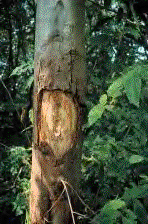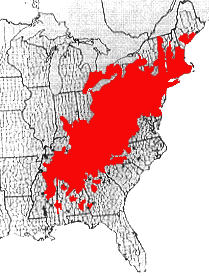The figure on the right makes vivid the devastating effect the canker has on the American chestnut; it shows the canker of Chestnut blight that has encircled and killed an American chestnut tree.

Common Name:
Chestnut blight fungus, or Chestnut
bark disease
Scientific Name: Cryphonectria
parasitica (Murrill) Barr
Classification:
| The canker housing
the fungus can be either swollen or sunken, with the latter being the lethal
type that kills the tree. At first, the tree dies above the canker, although
it may continue to sprout below it. As sprouts grow, they, too, become
infected and die. Eventually, cankers spread throughout the tree surface,
killing the tree. Although young trees may succumb to the disease within
a year, mature trees may take years to succumb to the fungus.
The figure on the right makes vivid the devastating effect the canker has on the American chestnut; it shows the canker of Chestnut blight that has encircled and killed an American chestnut tree. |
 |
Original
Distribution:
The first study that looked into the source of the blight
fungus disease was commissioned in 1913 by the USDA. Frank Meyer, who led
the study for the USDA, reported in that year that the disease was found
on chestnut trees in mountainous uplands of China. Two years later, in
1915, Meyer also discovered the blight fungus disease in Japan, in mountainous
ranges where chestnut trees were growing. It has since been established
that both Japanese chestnut trees, (C. crenata Siebold and Zuccarini),
as
well as some Chinese chestnut trees (C. mollissima), are resistant
to the fungus. While they may become infected, they seldom are killed by
the fungus. In contrast, the American chestnut (Castanea dentata),
growing for centuries or thousands of years free of parasites, has not
developed a resistance to them, and succumbs easily to the disease.
| Current Distribution: The figure on the right shows the natural range of the American chestnut as presented by Saucier in 1973: eastern North America, from Mississippi to Maine, mostly on mountainous uplands that slope in an upwards, northeasterly direction. The disease has spread throught the native range, and has even killed trees planted outside the range. |
 |
Site and Date of Introduction: The blight fungus disease was first observed in the U.S. killing American chestnuts (Castanea dentata) in 1904. It has been widely accepted since that humans brought the disease to the US from Asia on imported chestnut trees. The first sighting of the fungus was at the Bronx Zoo, New York City. From there, the disease spread like fire throughout the eastern states, and across the entire natural range of the American chestnut. By the 1920s, the disease had even reached southern Ontario, and by the 1930s, the entire stock of American chestnuts was infected, with most of them dying. By 1940, over three and a half billion American chestnuts had been lost to the fungus. In less than four decades, a dominant American tree species had been converted to a threatened species.
Initial attempts to control and stem the further expansion of the fungus included chemical treatments, clearing and burning chestnut trees around infestation sites. However, none of these control attempts was successful, evidenced by the uncontrolled growth and spread of the fungus throughout the native range of the American chestnut.
Mode(s) of Introduction: In 1912, USDA scientists Metcalf and Collins hypothesized that Japanese chestnut trees (C. crenata Siebold and Zuccarini), which were first imported to the U.S. in 1876, were carriers of the disease and responsible for its spread in this country. Within a few years, it had become clear that diseased imported chestnut trees from Japan were the most important contributing factor in the spread of the disease in the U.S. It should be noted that by 1900, many U.S. mail-order nurseries offered Japanese chestnut trees for sale throughout the country.
Reason(s) Why it has Become Established: Because the American chestnut had never before been exposed to this fungus, it was highly susceptible to the disease. American chestnut seedlings, in particular, were most susceptible. More mature trees (i.e., trees with more than 1.5 inches in diameter at breast height), may survive the disease, although they are not immune to it. Environmental stresses, such as high elevations, extreme heat or freezing temperatures may also reduce a tree's resistance to the blight fungus.
The blight fungus is carried from tree to tree by small animals and insects, who pick up and thansport the infected spores from tree cankers on their feet, fur, and feathers. The disease is also spread from tree to tree by weather elements such as wind and rain. Spores from an infected tree are lifted by wind or carried by rain to a healthy tree, entering it through cracks or wounds in the bark. The spores multiply rapidly and give rise to sunken cankers that expand and kill everything above the canker--usually in one season. It has been observed that a chestnut tree can die in as few as four days after being infected with the blight fungus.
Ecological Role: By attacking and killing the American chestnut, resulting in forest clearing and the removal of the forest canopy provided by large chestnut trees, the fungus indirectly benefits smaller hardwood trees, such as birch trees, replacing the American chestnut. Another ecological role of the fungus is that canker spores attract secondary insects and propagate their food web.
Benefit(s): Scientists at the Boyce Thompson Institute for Plant Research at Cornell University have found that, ironically, the Chestnut blight fungus may provide the basis for the development of future pharmaceuticals. The scientists are currently examining how chemical compounds are produced by the C. parasitica fungus, as well as native American and Asian medicinal herbs, such as aloe, buckthorn and rhubarb. According to these scientists, isolating the genes for the therapeutic compounds extracted from the fungus should be relatively easy, compared to isolating similar genes from plants.
The fungus has been found to produce biologically active chemicals that reportedly have antiviral, antimicrobial, immunosupression and anticancer activities. It is ironic that an invasive species such as the blight fungus, that has spread so much devastation to an ecologically and commercially important native species such as the American chestnut, is also associated with breakthrough medical research and potential public health benefit.
Threat(s): The introduction and rapid spread of the blight fungus throughout the natural range of the American chestnut has killed almost all large American chestnut trees. The American chestnut has for centuries been prized for its fruit and its beautiful, decay-resistant wood. This tree has also played an important role in the ecosystem: by growing in rich woods to heights of 100 feet or more, and with a canopy diameter of over 100 feet, the American chestnut has provided cover, shade, food, and nutrients for most other, lower tree species and shrubs. The threats to the ecosystem created by its loss to the blight fungus are apparent: the fungus disrupted the habitat and food web of the abundant and diverse plant and animal life that thrived in the American chestnut's shade and depended on its food source (nuts) and rich-soil for subsistence.
In addition to the ecological threats, the fungus has also become a threat for industry and the economy. As stated above, chestnut wood is highly resistant to decay and rot, and has been used extensively for poles, fencing, and building materials. While the Chinese tree is an orchard tree, the American chestnut has historically created large tracts of big timber.
Although currently imported healthy Chinese chestnut trees provide most of the chestnut supply for the U.S. market, these imported trees cannot replace our native chestnut.
Control Level
Diagnosis:
Highest Priority
Due to the rapid spread of the blight
fungus, by the 1950s the American chestnut had been reduced to a threatened
species. Almost the entire population had become infected with the blight
fungus. As it was impossible for resistance to the fungus to evolve (once
trees are killed, any sprouts die before they become sexually mature),
it was urgent that highest-priority conservation efforts be launched to
save the American chestnut from extinction.
Thanks to conservation efforts such as those cited below, the American chestnut, which risked extinction in the late 1950s, has once again emerged. These efforts offer hope that one day, we will be able to restore the American chestnut forests lost to the disease, restoring this beautiful tree's ecological and commercial benefits.
Control Method: Two methods of restoration of the American chestnut include a) the use of hypovirulent strains and b) hybridization.
The primary control method for the Chestnut blight fungus is biological control through inoculation. Hypovirulence is a viral disease of the blight fungus, whose "hypovirulent" or weakened strains were first imported from Italy in the 1960s. Weakened by the virus, the blight's course is slowed down, so that a chestnut tree, which would otherwise have no resistance to the fungus and die, can develop resistance to the disease. Remarkably, in study after study, inoculation of these weakened viral strains into lethal cankers on the American chestnut has resulted in canker remission.
Breakthrough control of the blight fungus will be achieved when scientists will successfully manipulate hypovirulence to develop an economical and effective biocontrol method to restore the American chestnut. There are several obstacles scientists are facing in this effort, the most notable of which is that the blight fungus spreads very rapidly, while hypovirulence spreads very slowly.
Another successful conservation effort to restore the American chestnut has been the introduction of breeding plans by the American Chestnut Foundation and the Connecticut Agricultural Experiment Station. A back-cross breeding system was launched, with resistant Japanese and Chinese chestnut trees crossed with susceptible American trees, and with the partially-resistant hybrids crossed several times to native American trees. (Japanese chestnut trees are more resistant to the blight fungus than Chinese chestnuts; both offer superior resistance to the fungus than the American chestnut.) This repeated back-crossing increased the percentage of both American genes and resistant genes in the hybrids.
An integrated control system is critically needed to stem the course of the blight fungus and seek to recover the native American chestnut. The combined use of hypovirulence (through inoculation) and blight resistance (through grafting) would produce effective blight control. Numerous examples of the successful application of integrated control have proven that the fungus can be controlled, if an economical, integrated biocontrol method is developed for widespread application throughout the natural range of the American chestnut.
References:
American Chestnut Cooperators' Foundation. American Chestnut Habitat. http://www.ppws.vt.edu/griffin/accfhab.html
American Chestnut Cooperators' Foundation. Blight Fungus. http://www.ppws.vt.edu/griffin/blight.html
American Chestnut Cooperators' Foundation. Integrated Management for Chestnut Blight Control. http://www.accf-online.org/Blight/Control/integrat.html
APSnet. Revitalization of the Majestic Chestnut: Chestnut Blight Disease (December, 2000). http://www.apsnet.org/online/feature/chestnut/top.html
Forest Health Protection, Southern Region. Chestnut Blight, caused by Endothia parasitica. http://fhpr8.srs.fs.fed.us/idotis/diseases/chestnut.html
Friedlander, Blaine P., Jr. Scientists Use Genetic and Chemical Arsenals in Fight for American Chestnut. Cornell Chronicle, December, 2001. http://www.news.cornell.edu/Chronicles/12.6.01/chestnut_blight.html
Patel, Moneil. American Chestnut Blight and the Conservation of Chestnut Trees. http://darwin.bio.uci.edu/~sustain/global/sensem/patel297.html
Tom Volk's Fungus of the Month. Cryphonectria parasitica, the Cause of Chestnut Blight (May, 1998). http://www.wisc.edu/botany/fungi/may98.html
Author: Julia Rellou
Last Edited: March 15, 2002